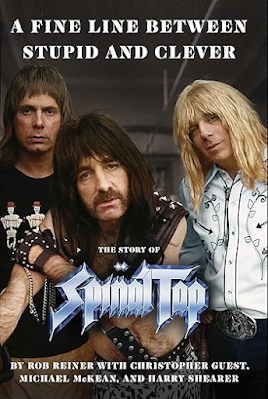 |
| I'm howling... |
Werewolves were my thing, for whatever reason. Maybe I, powerless but with a powerful hunger, felt the urge to shed my weakness and transform. I will leave the psychoanalysis to the more qualified. The best of the werewolf flicks was and remains An American Werewolf in London. The original Howling wasn’t bad either, and watching that led me to The Howling II: Your Sister is a Werewolf. Which is, charitably, a flawed film. The male lead is one of the worst I’ve ever seen, so wooden you could build a bridge out of him (joke rental courtesy Monty Python). The plot barely hangs together, though somehow it manages to be entertaining. It’s saved by a time-machine 80s vibe, the great Christopher Lee (the film’s entire acting budget must have been spent on him), and by Sybil Danning. The Howling II is basically an excuse to get her on film, a vehicle for her display, and for good reason. She's smoking!
The Monsters, Magic, and Madness podcast* recently hosted the B film actress for an interview. Danning genuinely loves the film as well as her other roles in immortal sexploitation classics like The Long Swift Sword of Siegfried (1971). I’m cool with that. I love weird B cinema too, even if the Howling II makes one howl (and wince, and cringe). I love 80s metal and S&S and so can cast no stones. We need not take life so seriously.
Danning in Howling II spends most of her time in a wild powersuit, half sci-fi, reflective silver and black, topped with 80s shoulder pads. It shows plenty of skin--exposed hips and wide open from neck to navel. Danning chews scenery like a blood-hungry werewolf. Which she is. Sorry for the spoiler.
And then like a thunderbolt I realized it was time for my top 5 hottest horror movie babes of the 70s and 80s. With a couple honorable mentions thrown in.
I’m going deeper on these selections, so no Jamie Lee Curtis (beautiful, but safe and predictable) or Heather Langenkamp (everyone had a crush on her, but too teen normal and staid). My choices lean into full on sexy, wild, and B movie offbeat.
1. Sybil Danning. I grew chest hair the first time I saw her de-robe and transform into a she-wolf. Here is something to watch.
2. Amanda Donohoe. The Lair of the White Worm is a cult classic in every sense (ancient snake cult exists in the British Countryside), and a lot of tongue-in-cheek fun. I love this film unreservedly but Donohoe’s turn as Lady Sylvia makes it. She’s funny, wicked, drop-dead gorgeous, and sexy as hell, and the best realized character on this list.
3. Caroline Williams. The Texas Chainsaw Massacre Part 2 has some parallels to The Howling II. Both are campy, comic albeit packed with carnage and scares. And each is bolstered by a hot female lead. Williams as the harassed DJ Stretch is irresistible in blue jean shorts.
4. Ingrid Pitt. What can I say about Pitt that hasn’t already been said? The late Polish actress (1937-2010) and Nazi concentration camp survivor was absolutely stunning. She’s probably best known for her roles in a pair of classic Hammer horror films from the early 1970s—The Vampire Lovers and Countess Dracula. Time stops when she’s on screen.
5. Linnea Quigley. If you’ve ever seen Return of the Living Dead (1985) you know the show-stopping dance. Quigley earned “scream queen” status for a string of horror movies in the 80s but RotLD alone would put her on this list.
Honorable mentions
Adrienne Barbeau. Always loved her toughness and edge (and fantastic body, TBH). Underrated actress. But I felt like she could break me in half then (and now). Can she really be 80?
Catherine Mary Stewart. Major crush on her as a kid (and perhaps now?). Only makes honorable mention because Night of the Comet is arguably SF, and she ventures into too popular/safe territory with roles in Weekend at Bernie’s and The Last Starfighter.
*Recommended BTW. Monsters, Madness, and Magic has stayed in my rotation with its eclectic lineup of semi-obscure celebrity interviews you don’t get anywhere else.
 |
| Ingrid Pitt |
 |
| Caroline Williams |
 |
| Linnea Quigley |
 |
| Amanda Donohoe |

























